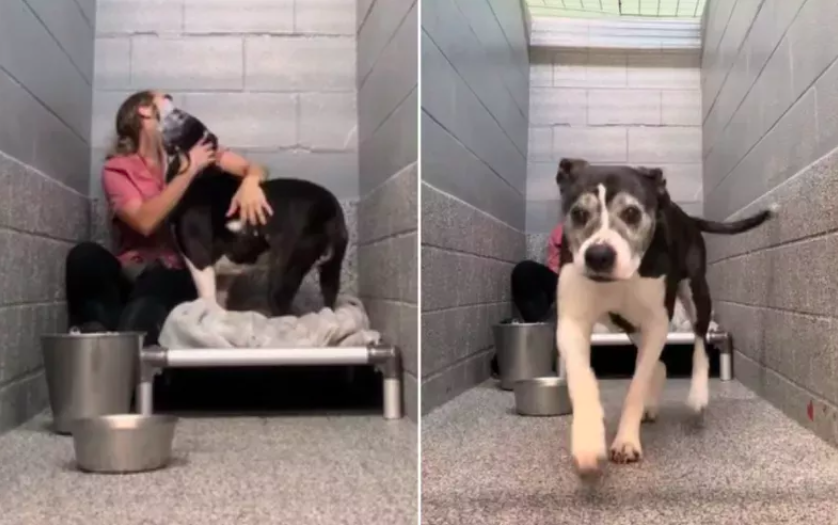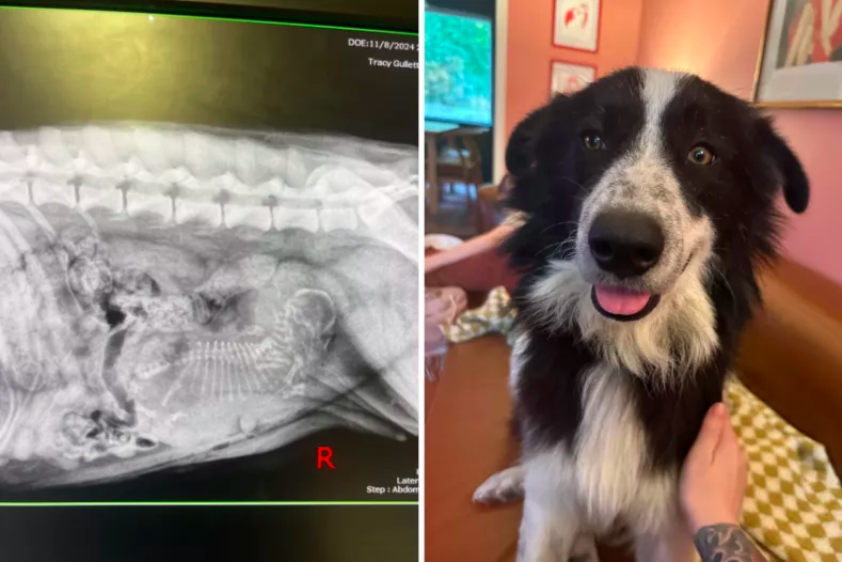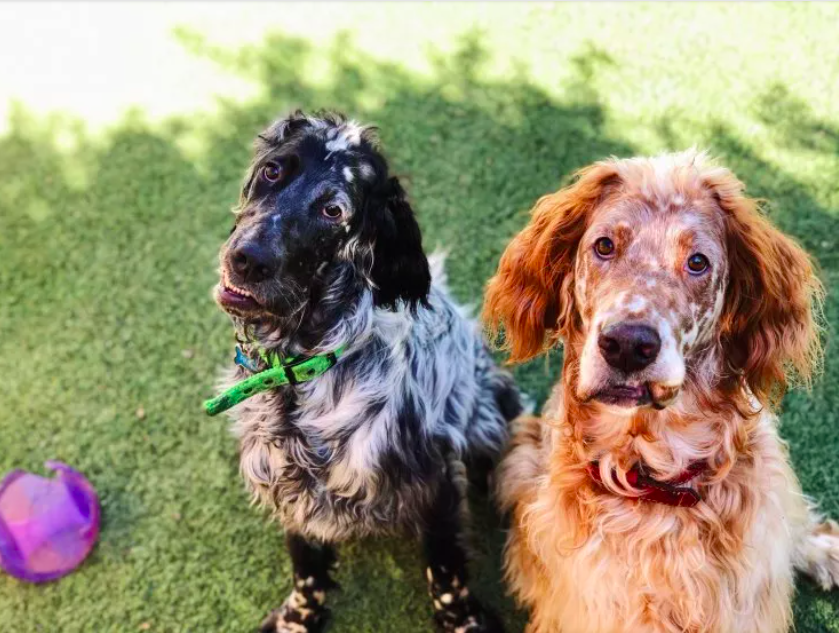Trending Pet Stories
Urban Explorers Discover Dogs in Abandoned Chicago Hospital

Urban Explorers Discover Dogs in Abandoned Chicago Hospital
In a recent viral discovery, urban explorers stumbled upon an unexpected and heartwarming sight – a group of dogs residing in an abandoned hospital in Chicago. The explorers captured the moment on video, sparking curiosity and concern among viewers about what happened to the animals afterward. Here’s a deep dive into their discovery and the broader context around homeless animals and urban exploration.
The Unexpected Discovery of Dogs Inside an Abandoned Hospital
Urban exploration, a popular trend that involves venturing into forgotten or abandoned locations, led Instagram user @lordexplores and a companion to an old, deserted hospital. In a video shared on social media, the explorers recount the eerie experience as they approached a room filled with barking dogs. Caught between curiosity and caution, they cautiously assessed the situation. Here’s how they made sense of what they saw:
Signs of Human Presence
- Supplies in the Room: The room had supplies, indicating that someone might have been taking care of the dogs.
- A Locked Door: A chair was wedged against the door, suggesting it was intentionally closed off.
Uncertain about the situation, they decided to leave quickly, fearing they might disrupt something.
Returning with Aid – A Second Visit
Three days later, @lordexplores returned to the site with food for the dogs. By then, the dogs and any human caretakers had left, but the explorers noticed personal items left behind, such as propane tanks and a sleeping bag, which further indicated someone had been residing there temporarily.
Why People Live in Abandoned Buildings
The presence of both people and animals in abandoned buildings isn’t uncommon. According to the 2023 Annual Homelessness Assessment Report by the U.S. Department of Housing and Urban Development (HUD), homelessness in America rose by over 70,000 people in the last year, with many individuals residing in locations like abandoned buildings.
Statistics on Unsheltered Homelessness
- In the U.S.: Approximately 653,100 people experienced homelessness in 2023, with 40% living in unsheltered conditions.
- Chicago’s Homeless Population: Chicago reported a 65% increase in unsheltered individuals in 2023, including many living in places not meant for habitation, such as vacant hospitals or buildings.
Community Reactions to the Dog Discovery
After the explorers shared their video online, viewers expressed varied reactions. Many were quick to point out that the dogs appeared well-fed and healthy, suggesting they were not abandoned but under the care of a person without a permanent home. Here are some comments that reflect public sentiment:
- Well-Cared-For Dogs: Commenters noted the dogs’ healthy appearances, supporting the idea that a homeless person might have been caring for them.
- Concern for Safety: Some viewers expressed concern about the potential risks of encountering dogs in abandoned spaces, especially if they’re being used as protectors.
Homelessness and Pet Ownership: A Complicated Reality
Many homeless individuals have pets, providing them with companionship, protection, and emotional support. Organizations working with the homeless note that pet ownership can enhance mental health and provide a sense of stability in an otherwise unstable environment.
Why Homeless Individuals Keep Pets
- Companionship: Pets offer emotional support and a sense of purpose.
- Security: Dogs, in particular, provide a level of security for their owners.
- Emotional Well-Being: Studies show that pets can positively impact mental health, which is vital for those facing the challenges of homelessness.
The Challenges of Animals in Abandoned Places
Abandoned buildings are attractive to homeless individuals seeking shelter, but they pose significant risks, especially when animals are involved. Dogs in such environments can act protectively, which could endanger explorers or other passersby. Yet, it’s clear these animals are often deeply bonded with their owners.
What Urban Explorers Should Keep in Mind
Urban explorers often encounter animals in vacant spaces, which can lead to complex situations. Here are some tips for explorers encountering animals in abandoned buildings:
- Stay Calm: Animals may act protectively, so maintain a calm demeanor.
- Avoid Intruding: If there’s evidence someone is living there, respect their space.
- Contact Authorities if Needed: In cases where animals appear distressed, alert local animal services.
The Importance of Awareness and Compassion
Homelessness and animal welfare are deeply interconnected issues, highlighting the importance of community resources and compassion. Many animal shelters and non-profits work to provide services to homeless pet owners, recognizing the bond between them. It’s essential for communities to offer resources that accommodate both people and their pets.
Resources for Homeless Pet Owners
Several organizations across the U.S. offer support for homeless pet owners, providing food, shelter, and healthcare for animals. Resources such as:
- Pets of the Homeless: A national organization helping homeless pet owners with supplies and medical aid.
- Local Shelters and Food Banks: Many shelters have programs that offer pet food and medical services.
Final Thoughts
The explorers’ discovery in the abandoned hospital draws attention to the overlooked lives of homeless individuals and their pets. Their experience sheds light on the need for better support systems, emphasizing the importance of compassion for both human and animal lives in challenging situations.
Frequently Asked Questions (FAQs)
Why did the explorers leave the dogs behind?
They observed signs of human presence and didn’t want to intrude, so they left to avoid conflict.
Are pets commonly found in abandoned buildings?
Yes, especially in areas with a significant homeless population. Pets provide companionship and protection to those living in such conditions.
How can urban explorers respond to animals in abandoned buildings?
It’s best to stay calm, respect the animals’ space, and avoid interacting with them unless they appear in distress.
What resources are available for homeless pet owners?
Organizations like Pets of the Homeless offer food, shelter, and healthcare for pets owned by homeless individuals.
What impact does pet ownership have on homeless individuals?
Pets provide emotional support, companionship, and security, which can improve the mental well-being of homeless individuals.
We appreciate you for taking the time to read this article!
Finally, we hope you found this article interesting? And what do you think about ”Urban Explorers Discover Dogs in Abandoned Chicago Hospital!?”
Please feel free to share or inform your friends about this article and this site, thanks!
And let us know if you observe something that isn’t quite right.
For more information on this topic, read the original article from Newsweek here.
Trending Pet Stories
Dog Shelter’s Longest Resident: Grandma’s Sweetest Reaction to a Visitor

Dog Shelter’s Longest Resident: Grandma’s Sweetest Reaction to a Visitor
Introduction: A Heartwarming Tale of Resilience
Animal shelters across the U.S. are filled with dogs longing for forever homes, but few stories are as touching as that of Grandma, a 9-year-old boxer-pit bull mix. As the longest-term resident at Junction City Animal Shelter in Kansas, Grandma’s tale highlights the struggles and incredible love senior dogs offer.
In this article, we explore Grandma’s journey, her charming personality, and the challenges faced by older shelter dogs like her.
Grandma’s Arrival: Abandoned but Not Broken
Grandma’s journey began on November 5, 2023, when she arrived at Junction City Animal Shelter as a stray. Shelter staff later found her previous owner, who could no longer care for her. Vanessa Gray, the shelter director, shared:
“Grandma is an older gal with a nurturing demeanor that inspired her name.”
Despite her difficult start, Grandma quickly endeared herself to the shelter staff with her gentle nature and resilience.
Getting to Know Grandma: A Special Soul
Over time, Grandma revealed her unique personality and preferences:
- Loves Cozy Blankets: Grandma enjoys snuggling up in soft blankets.
- Sunbathing Enthusiast: She relishes roaming the yard and soaking up the sun.
- Playful Companion: From fetch to chew toys, Grandma’s playful side shines.
Her affectionate demeanor and love for human interaction make her a perfect candidate for a loving home.
Why Senior Dogs Like Grandma Face Challenges
Sadly, Grandma’s story isn’t unique. Senior shelter dogs often face longer waits for adoption. A 2021 study in the Animals journal found common traits in long-term shelter residents:
- Older age.
- Larger size.
- Belonging to misunderstood breeds.
- Specific needs, such as being the only pet in the home.
For Grandma, her age, size, and breed have created challenges in attracting adopters.
A Viral Moment: Grandma’s Reaction to a Visitor
Recently, Junction City Animal Shelter shared a video of Grandma on TikTok. The clip shows her joyfully interacting with a staff member, eagerly wagging her tail and playing. The caption, “I’m not crying… you’re crying,” perfectly captures the emotional moment.
This viral footage highlights Grandma’s loving nature and proves she’s still full of life, ready for a family to cherish her.
Life in a Shelter: The Toll on Senior Dogs
Shelter life can be tough for older dogs like Grandma. While she handles the noise and routine better than many, the lack of a permanent home takes its toll. Gray shared:
“This is still not the place for any animal, especially a senior. There is so much noise.”
Fortunately, Junction City Shelter doesn’t euthanize animals, giving Grandma the time she needs to find a family.
What Makes Grandma the Perfect Pet?
Grandma is a loving and low-maintenance companion. Here’s what makes her ideal:
- Solo Star: She thrives in homes without other pets.
- Easygoing Nature: Grandma enjoys her independence but loves human attention.
- Perfect for Any Home: Her calm demeanor makes her suitable for families or individuals.
Advocating for Senior Dogs Like Grandma
Grandma’s story represents countless senior dogs in shelters. Adopting an older dog comes with unique rewards:
- Calm Temperament: Senior dogs are often more predictable and relaxed.
- Deep Bonding: Older dogs form strong emotional connections with adopters.
- Gratitude: They often show immense appreciation for their new homes.
How You Can Help
If you’re moved by Grandma’s story, here are ways to make a difference:
- Adopt: Open your heart and home to a senior dog.
- Volunteer: Spend time with shelter animals to brighten their days.
- Donate: Support shelters with supplies or financial aid.
- Share: Spread the word about adoptable senior pets like Grandma.
Conclusion: Grandma’s Forever Home Awaits
Grandma’s journey is a testament to resilience and unconditional love. As the shelter staff work tirelessly to find her the perfect home, her story reminds us of the joy and companionship senior dogs bring.
Could you be the one to give Grandma the life she deserves? Visit Junction City Animal Shelter to meet her today.
FAQs About Senior Dog Adoption
Why adopt a senior dog?
Senior dogs are calm, loving, and often trained, making them excellent companions.
Are older dogs harder to care for?
While they may require more vet visits, their mature temperament often makes them easier to manage than younger dogs.
Can senior dogs adjust to new homes?
Yes! With patience and love, senior dogs adapt quickly and bond deeply with their families.
What challenges do senior shelter dogs face?
Older dogs often struggle with age-related stigma, breed stereotypes, and limited interest from adopters.
How can I help if I can’t adopt?
You can volunteer, donate, or share stories of senior dogs to raise awareness and support their adoption.
We appreciate you for taking the time to read this article!
Finally, we hope you found this article interesting? And what do you think about ”Dog Shelter’s Longest Resident: Grandma’s Sweetest Reaction to a Visitor!?”
Please feel free to share or inform your friends about this article and this site, thanks!
And let us know if you observe something that isn’t quite right.
References: Newsweek Original Article
Trending Pet Stories
Gift Guide 2024: The Best Gifts for Pet Owners
Trending Pet Stories
Routine Spay Appointment Reveals Shocking Secret About Rescue Dog

Routine Spay Appointment Reveals Shocking Secret About Rescue Dog
When a Tennessee woman decided to spay her newly adopted rescue dog, Salem, she never imagined the twist that would follow. In an unexpected revelation, a routine veterinary procedure unveiled a surprising truth that captivated pet lovers online.
Adopting Salem: A New Beginning
Haley Houghmaster and her family adopted Salem, an Australian shepherd and border collie mix, on October 26, 2024. Salem joined their family from Happy Tails Canine Rescue, a Memphis-based organization dedicated to helping stray and abandoned dogs find loving homes. According to Haley, Salem had seamlessly adjusted to her new surroundings, quickly becoming a beloved member of the household.
A Routine Appointment Turned Extraordinary
On November 3, just over a week after Salem’s adoption, Haley brought her to the vet for a spay appointment. What was supposed to be a standard procedure took an unexpected turn.
Once under anesthesia, the veterinarian made an incision and discovered Salem was heavily pregnant—with only one puppy. Haley shared the surprising news on Reddit, where her story quickly gained traction.
“Found out at spay appointment that my new rescue dog is pregnant with one puppy,” Haley captioned her Reddit post, accompanied by Salem’s X-ray image.
What Are Singleton Puppies?
Singleton puppies, or single-litter puppies, are a rarity in the canine world. According to pet experts, this condition can result from several factors, including a dog’s age, genetics, or environmental influences.
Why Are Singleton Puppies So Rare?
- Breed and Genetics: Certain breeds are more prone to single-litter births due to their genetic makeup.
- Stress and Environment: External stressors can influence the size of a dog’s litter.
- Health and Age: Older dogs or those with unique health conditions are more likely to carry fewer puppies.
Risks Associated with Singleton Births
While the thought of a single puppy might seem adorable, it does come with its challenges.
Potential Complications
- Labor Induction Issues: Typically, puppies induce labor by releasing cortisol. With only one puppy, there might not be enough hormone production, which could delay labor and necessitate a C-section.
- Placental Limits: A dog’s placenta is viable for about 63 days. If labor doesn’t occur by day 65, veterinary intervention becomes critical.
- Socialization Concerns: Singleton puppies may miss out on the crucial social interactions provided by littermates, potentially leading to behavioral challenges.
- Lactation Issues: A single puppy may not trigger sufficient milk production, depriving it of colostrum, the nutrient-rich first milk.
Haley’s Decision: Embracing the Miracle
Despite the risks, Haley decided to let Salem carry the pregnancy to term. Terminating at this stage could have posed significant dangers to Salem’s health.
“Since it’s just one puppy, I chose to keep it and let her try to deliver naturally,” Haley explained.
Salem is expected to deliver any day now, and Haley remains optimistic for a smooth delivery.
Expert Insights on Singleton Puppies
Dr. Harunur Rashid, in an article for Vet Advises, emphasizes that while rare, singleton litters are not unheard of. However, veterinarians need to monitor these pregnancies closely to ensure the safety of both the mother and puppy.
Dr. Marty Greer, a veterinarian at Revival Animal Health, notes that C-sections are often necessary in such cases. Without the natural triggers for labor, complications can arise, putting both mother and pup at risk.
A Viral Sensation: Salem’s Story Captures Hearts Online
Haley’s Reddit post resonated with pet lovers worldwide, garnering over 12,000 upvotes and hundreds of comments.
- “Congrats! She looks like a happy momma-to-be,” one user remarked.
- “What a surprise! We had a similar experience with our rescue,” another shared.
- Some cautioned Haley, noting that X-rays aren’t always precise: “Our vet said two puppies, but we ended up with eight!”
Found out at spay appt that my new rescue dog is pregnant with 1 puppy 😅
byu/Pipsmagee2 inDogAdvice
What’s Next for Salem and Her Puppy?
As Salem approaches her due date, Haley and her family are preparing for the arrival of their newest furry family member. They’re hopeful for an uneventful delivery and are excited to meet the puppy who has already captured so much attention.
Conclusion: A Rescue Dog’s Unexpected Journey
Salem’s story is a heartwarming reminder of the surprises life can bring, even in the most routine situations. Her journey from rescue dog to expectant mother has inspired thousands, showcasing the unpredictable beauty of life.
Frequently Asked Questions (FAQs)
What are singleton puppies?
Singleton puppies refer to litters with only one puppy. This condition is rare and influenced by factors such as breed, genetics, and environment.
Can singleton pregnancies be risky for dogs?
Yes, singleton pregnancies can pose risks, including complications during labor and insufficient milk production for the puppy.
How can vets help singleton pregnancies?
Veterinarians closely monitor singleton pregnancies and often recommend C-sections if natural labor doesn’t begin within the expected timeframe.
Why do singleton puppies face socialization issues?
Without littermates, singleton puppies may miss out on critical interactions that help develop their social and behavioral skills.
What should owners of singleton puppies do?
Owners should provide extra care, socialization opportunities, and veterinary checkups to ensure the puppy’s physical and emotional well-being.
We appreciate you for taking the time to read this article!
Finally, we hope you found this article interesting? And what do you think about ”Routine Spay Appointment Reveals Shocking Secret About Rescue Dog!?”
Please feel free to share or inform your friends about this article and this site, thanks!
And let us know if you observe something that isn’t quite right.
References: the original article on Newsweek.
-

 Pet Care2 years ago
Pet Care2 years agoThe Best Dog Collars For 2022
-

 Dogs2 years ago
Dogs2 years agoBichon Frise: The Happy, Playful, and Cuddly Companion
-

 Trending Pet Stories1 year ago
Trending Pet Stories1 year ago2023 ‘World’s Ugliest Dog’ Winner: Scooter’s Tale of Resilience
-

 Animals3 years ago
Animals3 years agoAre There Animals Having Down Syndrome?
-

 Pets2 years ago
Pets2 years agoThe Fascinating World Of The Red Chameleon
-

 Dogs3 years ago
Dogs3 years agoTop 10 Most Popular Dog Breeds According To AKC.
-

 Dogs3 years ago
Dogs3 years ago21 Dog Breeds That Resemble Bears Or Teddy Bears!
-

 Dogs3 years ago
Dogs3 years agoEskimo Dogs from Canada – What Are They? – Find Out!










